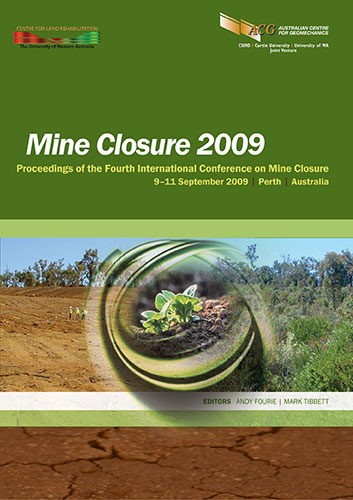Turning a mined-out pit into an aesthetically acceptable community asset — a novel approach to mine closure in Ghana, West Africa

|
Authors: Darpaah, GA; Theunissen, NH; Ohene-Adu, A; Owusu-Yeboah, P Paper is not available for download Contact Us |
DOI https://doi.org/10.36487/ACG_repo/908_29
Cite As:
Darpaah, GA, Theunissen, NH, Ohene-Adu, A & Owusu-Yeboah, P 2009, 'Turning a mined-out pit into an aesthetically acceptable community asset — a novel approach to mine closure in Ghana, West Africa', in AB Fourie & M Tibbett (eds), Mine Closure 2009: Proceedings of the Fourth International Conference on Mine Closure, Australian Centre for Geomechanics, Perth, pp. 389-401, https://doi.org/10.36487/ACG_repo/908_29
Abstract:
The Homasi gold mine concession extends over an area of 116 km2 and situated within a forested plateau physiographic region with elevations of 150–300 m above mean sea level. The concession was acquired by Ashanti Goldfields Company Limited (subsequently AngloGold Ashanti (Ghana) Limited) in November 2001. Mining activity commenced in June 2002 using conventional open pit methods. The excavated materials were hauled using rear-dump trucks for processing at existing oxide treatment plant located 20 km from the mine site. Mining activity was terminated in December 2003 and by 2005, the pit was filled with water with an estimated maximum depth of 45 m at daylight elevation. Under Ghana’s statutory laws, AngloGold Ashanti Ltd was obliged to decommission its activity by rehabilitating the affected areas including backfilling the pit among other obligations, and to restore it to its original state after terminating its operations. However, mindful of the impecunious state of the surrounding communities, the company applied to the Ghana Environmental Protection Agency (GEPA), through the decommissioning plan, for approval to install a sustainable development project that had the potential of transforming the mined-out pit into an internationally acceptable community asset with tourism potential, as an alternative plan to backfilling the pit. That singular act also has the potential to create livelihood projects and to reduce poverty and undernourishment within the riparian communities. Three major areas of activity were earmarked for action. These are: conversion of the mined-out pit into an aquaculture fish producing facility; suitably stabilise all the slopes of the high-grounds (waste rock dumps) and revegetate the area using indigenous forest trees; convert part of the banks of the pit into an amenity beach with well-engineered slopes and summer huts; and for its long term goals build 30 self-catering chalets, a swimming pool, gymnasium and a football field within the area of the closed mine. The facility in its full development will also have a scarp-walkway installed across the 120 m width span of the mined-out pit, at approximately 100 m above daylight elevation. Community farms comprising of fish farms integrated with livestock and leafy vegetable farming that recycle all ‘wastes’ for reuse in an environmentally friendly manner are being installed as a special package for the community. The project will be handed over to the communities to run as independent body after installation and a two year trial run. Presently, project installation is about 70% complete and offers employment to 40 people with a potential for additional 100 jobs at full project installation. This new approach adopted for mine closure by AngloGold Ashanti Ltd significantly demonstrates how a mined-out pit, seen as a liability to the communities, could be transformed into a legacy of hope in the form of sustainable projects that meet the needs of its stakeholders. The project design, installation and initial results, its impact on the environment, the role played by the communities in project installation and management and cost benefit analysis of this project, which has an initial capital outlay of US$ 880,000, is presented and its sustainability discussed.
References:
Acheampong, A.B. (2006) Decommissioning plan for the Homasi mined-out pits, Tropical Exploration and Mining
Company (TEMCO), Accra, Ghana, consultancy report, 59 p. (unpublished).
Andren E.L. (1976) Pollution and degradation of environment affecting aquaculture in Africa, In Committee on inland
fisheries of Africa (CIFA) symposium on aquaculture in Africa, reviews and experiences papers, CIFA technical
paper – CIFA/CR4/T4, Accra, Ghana, 30 September – 2 October, 1975, Food and Agriculture Organization
(FAO), Rome, supplement 1, 794 p.
Ashanti Goldfields Company Ltd (AGC) (2002), Homasi gold concession feasibility study, AGC Ltd, Obuasi, Ghana,
feasibility report, (unpublished).
Environmental Protection Agency (EPA) (2005) Environmental statistics in perspective – country paper – Ghana,
Workshop on Environmental Statistics for the Economic Community for West African States (ECOWAS)
Region, Dakar, Senegal, 28 February – 4 March 2005, EPA secretariat, Accra, Ghana, situation report
(unpublished).
Environmental Protection Agency (EPA) (2007) Sector specific effluent quality guidelines for discharges into natural
waters, EPA Accra, Ghana, proposed manual on effluent and surface water standards in Ghana, (unpublished).
© Copyright 2025, Australian Centre for Geomechanics (ACG), The University of Western Australia. All rights reserved.
View copyright/legal information
Please direct any queries or error reports to repository-acg@uwa.edu.au
View copyright/legal information
Please direct any queries or error reports to repository-acg@uwa.edu.au